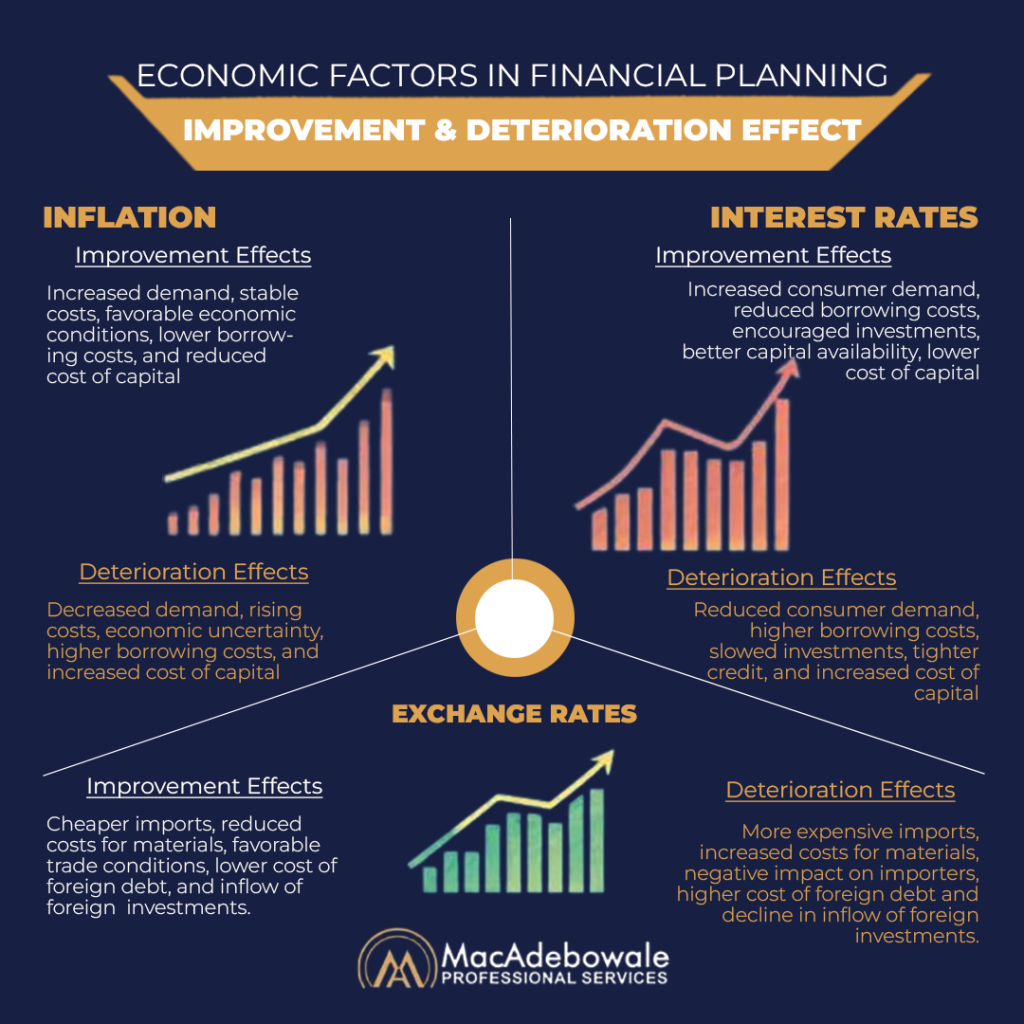Financial planning is essential for setting financial objectives, allocating resources, and ensuring the sustainable growth of a business. Hence, due care should be exercised when developing the financial plan of your company.
One of the keys to effective planning is to ensure that all the necessary factors are considered, including external factors outside the control of the organization. A clear understanding of these factors and how they affect the business is therefore very important to the success of any business plan. One of the most crucial set of factors that affect businesses are the macroeconomic factors, due to the direct impact they have on the profitability, cashflows and growth of businesses .
In this article, we will explore the macroeconomic factors you need to consider when planning, the effects they have on your business and the strategic considerations to be made when crafting a financial plan for your business.
Relevant Macro-Economic Factors to Consider When Planning
Macroeconomic factors shape the economic environment in which businesses, their entire industry and stakeholders, such as customers and suppliers operate. Therefore, their impact on every business is far-reaching.
Understanding these factors helps you develop effective financial strategies and ensure the long-term success of your business. These factors include inflation, interest rates (Monetary Policy Rate- MPR), and exchange rates.
Let’s take a deeper look at each of these factors:
- Inflation: Inflation refers to the index or measure of the change in the prices of general goods and services over a period of time, usually a year. Inflation affects the purchasing power of money, which influences consumer behaviour, cost structures, and pricing strategies. High inflation can erode profits, while low inflation can create opportunities for stable growth.
- Interest Rates (Monetary Policy Rate): Monetary policy rate refers to the interest rate at which a country’s central bank lends to commercial banks. It is used to influence the volume of money in circulation within an economy by either raising the rate to discourage borrowing and reduce the volume of money or reducing the rate to encourage borrowing and increase the volume of money. Changes in interest rates affect consumer spending, business investments, and economic stability.
- Exchange Rates: This refers to the value of one currency relative to another one. Fluctuations in exchange rates can impact international trade, the cost of imported goods, and the profitability of foreign investments.
Effects of Improvement or Deterioration of Macro-Economic Factors on Businesses
When macroeconomic factors improve or deteriorate, they cause a corresponding impact on the business environment, which affects the business as a whole. Here are the ways these factors can affect various essential aspects of the business environment.
- Inflation
Improvement (Decreasing Inflation):
- Customer Demand: Increased purchasing power translates to higher consumer spending.
• Costs: Lower inflation stabilizes costs for raw materials and labor, making them price-competitive and affordable.
• Economic Activities: Decreased inflation leads to predictable cost structures that encourage business investments and expansion.
• Availability of Funds: Stable inflation births lower interest rates, making borrowing more affordable.
• Cost of Capital: Reduces the cost of capital due to lower interest rates.
- Deterioration (Increasing Inflation):
• Customer demand: High inflation reduces customers’ purchasing power which affects their rate of demand.
• Costs: This leads to rising costs for raw materials, labor, and operational expenses, thus increasing the cost of running the business.
• Economic Activities: Uncertainty and rising costs birthed by high inflation lead to reduced business investments and slower expansion, thus slowing down the economic activity of the country.
• Availability of Funds: Higher inflation results in higher interest rates, making borrowing more expensive and funds less available.
• Cost of Capital: Higher inflation increases the cost of debt and capital.
2. Interest Rates (MPR, or Monetary Policy Rate)
- Improvement (Decreasing Interest Rates):
• Customer Demand: Lower interest rates lead to increased consumer borrowing and spending
• Costs: Reduced cost of debt lowers expenses related to borrowing.
• Economic Activities: Lower interest rates encourage business investments and expansion, which boost the economic growth of the country.
• Availability of Funds: Easier access to capital due to lower borrowing costs.
• Cost of Capital: Lower interest rates reduce the cost of capital.
- Deterioration (Increasing Interest Rates):
• Customer Demand: Higher interest rates reduce consumer borrowing and spending.
• Costs: The increased cost of debt raises expenses for businesses, which increases the cost of running the business.
• Economic Activities: Higher costs of borrowing slow down business investments and access to funds for expansion. This stagnates or slows down economic activity.
• Availability of Funds: Tighter credit conditions can limit access to capital.
• Cost of Capital: Higher interest rates increase the cost of debt and capital.
3. Exchange Rates
- Improvement (Strengthening Local Currency)
- Customer Demand: Imported goods become cheaper, increasing demand for these products.
- Costs: Lower costs for imported raw materials and components.
- Economic Activities: More favorable trade conditions for importing goods, as imported items are cheaper when the local currency increases in value. However, exported products become more expensive and less competitive in the international market.
- Availability of Funds: Foreign capital tends to flow into countries with stable currencies. Hence, more funds are available for businesses when the exchange rate is stable.
- Cost of Capital: Local currency appreciation results in a decrease in the cost of servicing foreign currency .
Deterioration (weakening local currency):
• Customer Demand: Imported goods become more expensive, and customer demand for them reduces. Consequently, the demand for locally produced items imcreases.
• Costs: Increased costs for imported raw materials.
• Economic activities; A weaker local currency negatively impacts importers as it results in more expensive imports, while it serves as a potential boost for exporters because exported goods become cheaper for overseas customers and more competitive in the international market.
Therefore, a weaker currency favours an export-oriented economy but leads to a decline in economic activities in an import-oriented economy.
• Availability of Funds: Rising exchange rates deter foreign investors from pumping in capital into an economy due to the loss in the value of the currency which depreciates the value of their investment. As a result, funds are less available due to the decline in the inflow of foreign capital.
• Cost of Capital: A higher exchange rate results in a higher cost of servicing foreign currency debt.

Strategic Considerations for Macro-Economic Factors in Financial Planning
- Inflation
When inflation decreases, this is the perfect time for your business to capitalize on the increased purchasing power of consumers to expand business operations and invest in growth initiatives. It is easier to plan and execute long-term projects during this period due to price stability birthed by lower inflation.
In an inflationary environment, you must implement efficient cost optimization strategies, such as renegotiating supplier contracts and improving operational efficiency, to reduce the cost of operation. Price increases may be required to maintain profit margins, but they should be implemented carefully to avoid losing customers. As a business, this is a period to consider holding off the execution of capital-intensive long-term projects in order to minimize cost.
2. Interest Rates (MPR, or Monetary Policy Rate)
When interest rates are low, borrowing costs decrease, which makes it an ideal time for businesses to raise funds through debt to finance expansion projects and capital investments. Also, customer spending tends to increase at this point, presenting opportunities for businesses to expand their reach and increase products to cater to all customer demands. This is a good time to launch new products in the market.
Businesses with existing debts can take advantage of this period and refinance them at a lower rate, which reduces interest expenses and enhances business profitability.
On the other hand, if the interest rate is rising, the cost of borrowing increases, making it essential to evaluate the timing of fund-raising and expansion plans carefully. To raise capital, opt for issuing equity instead of taking on debt to avoid high-interest expenses. Also, businesses have to implement cost optimization techniques to offset increased financing costs and strengthen their balance sheets by paying down existing debt to manage cash flow. By doing this, the increased interest rate will have little or no impact on the business’s profitability or sustenance.
3. Exchange Rates
A strengthened local currency reduces the cost of imports, benefiting local businesses that rely on imported raw materials and components. Also, it leads to higher competitiveness as the environment becomes favorable for expanding or starting new businesses.
A weakened local currency increases import costs, and as a local business, you might need to consider local sourcing to mitigate the impact of higher import prices. Businesses can incorporate Hedging strategies, such as forward contracts or options, to protect themselves against currency fluctuations. Raising funds through local currency debt can be an advantageous step to avoid the increased cost of servicing foreign currency debt. If your company is into exporting, you may need to expand as your goods and services become more competitive in the global market.
Final Words
Sometimes these macroeconomic factors can be so complicated that it gives your business a hard time to navigate. However, despite the situation, you can always trust MacAdebowale Professional Service to navigate the complexities.
At MacAdebowale Professional Service, we provide comprehensive financial planning solutions tailored to your unique needs. Our expert team will help you analyze critical macroeconomic factors, optimize your financial strategies, and ensure sustainable growth for your business. Don’t leave your financial success to chance—partner with us today and take the first step towards a more prosperous future for your business.
Contact MacAdebowale Professional Service at macadebowaleadvisory@gmail.com now for a consultation and let’s build a robust financial plan together!





